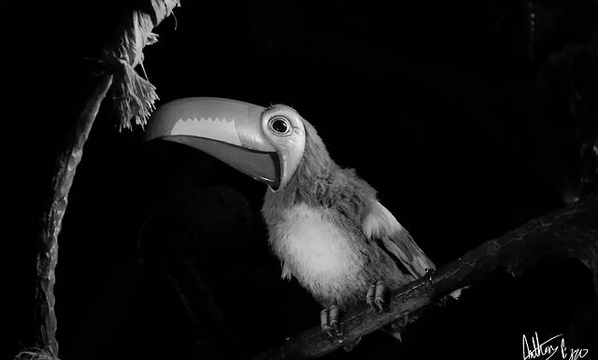This week’s article is kindly provided for me by Anthony Pizzo, whose Tiki Room experiences are more recent than mine! Unfortunately, he wasn’t able to log in for himself.
Prohibition went into effect in the United States on January 17, 1920, forcing drinking underground and causing a bootlegging boom. Established crime syndicates immediately got in on the action, but so did a lot of otherwise ordinary people, who traveled to nearby countries – especially island nations in the Atlantic and South Pacific – where alcohol wasn’t vilified in order to pick up stock. In many cases smuggling became a family affair, which is how a young man named Ernest Beaumont-Gantt came to visit many South Pacific islands with his father and develop a keen interest in the cultures found there. When prohibition ended in 1933, Ernest took what he had seen and distilled it into a themed bar and restaurant in Hollywood called Don’s Beachcomber – later Don the Beachcomber – America’s first Tiki-themed bar, and the ostensible flashpoint in the country’s interest in so-called Tiki Culture.
Historical and cultural dominos continued to fall from there, including multiple Hollywood films set in tropical locales, the opening of Trader Vic’s (directly inspired by Don’s Beachcomber), servicemen stationed in the South Pacific during World War II, the novel Kon-Tiki, and affordable air travel. All of which to say that the American fascination with Tiki Culture was well-sustained for over 30 years by the time Walt Disney’s Enchanted Tiki Room opened at Disneyland in 1963.
As with many Disneyland attractions, development of the show happened in tandem with the development of new technology. While on a trip to New Orleans, Walt Disney acquired a small mechanical bird, which he then passed on to WED Enterprises (now Walt Disney Imagineering), believing they could improve on the basic idea. It was electrician Lee Adams who modified the bird until it became what would be called an Audio-Animatronic, a robot which can move in sync with self-projected audio. Originally, the singing birds were going be entertainment in a restaurant, but that idea was quickly nixed when Walt found the birds too entertaining. (He also, probably correctly, assumed that patrons wouldn’t leave the restaurant, for want of seeing what the birds would do next.)
Though the show would eventually obtain corporate sponsorship, which is how most Disney rides get built and pay for maintenance/upkeep, Walt financed the Tiki Room out of his own pocket, which is why the full name of the attraction is Walt Disney’s Enchanted Tiki Room and why, for its first several years of operation, the Tiki Room had a separate paid admission of 75 cents. (Meaning it was not covered by the book of attraction tickets one could buy upon entering the park. Click here to learn more: https://www.the-solute.com/disney-byways-tickets/)
The show is a musical revue, featuring performances from various birds, plants, and Tiki idols, the first of which is “The Tiki, Tiki, Tiki Room.” While probably less well-known than “Yo Ho (A Pirate’s Life For Me)” or “Grim Grinning Ghosts,” chances are you if you start singing the song, chances are good that someone will be able to join in. This is one of two original songs written for the show by the Sherman Brothers (the other being “Let’s All Sing Like the Birdies Sing”), and it immediately sets the tone as a lighthearted, funny tribute to the music and approximation of Polynesian culture. In many instances that crosses over into appropriation, but based on a handful of critiques from Native Hawaiian there appear to be fewer heinously offensive aspects than you might expect from a musical comedy conceived in the 1960s by a bunch of largely white men.
As mentioned much further above, the affordability of post-war air travel helped to codify Tiki Culture in America, and cemented Pacific islands like Hawai’i as tourist destinations, so it was fitting that the first sponsor of Walt Disney’s Enchanted Tiki Room was United Airlines. They remained the sponsor for the first 12 years of the show, after which the Dole Food Company took over.* If United Airlines was a fitting sponsor, Dole was a darkly ironic one, as the family was instrumental in the coup d’état by Pro-American business interests which deposed Queen Lili’uokalani and overthrew the native Hawai’ian government in 1893. (Sanford B. Dole was named president of the Provisional Government of Hawai’i, and six years later his cousin James arrived on the island and founded what would become Dole Pineapple.)
Despite its age, Walt Disney’s Enchanted Tiki Room is still very popular with guests. There was an attempt to update it with The Enchanted Tiki Room: Under New Management, which featured two Disney Renaissance characters (Iago and Zazu), a handful of pop song parodies, massive amounts of grating irony and cynicism, and was generally more culturally insensitive. This had a relatively brief reign of thirteen years before a fire destroyed one of the key new animatronics, and a shortened version of the original show was restored. It’s a charming, slightly hokey show, but it turns out the allure of the region is as strong as ever, and the worst thing one can do it overthink it.
*There wasn’t a place for this in the main body, but no discussion of Walt Disney’s Enchanted Tiki Room and its Dole sponsorship would be complete without mention of the iconic Dole Whip. However, despite feeling like it’s always been there, the Dole Whip was only introduced in 1984.


